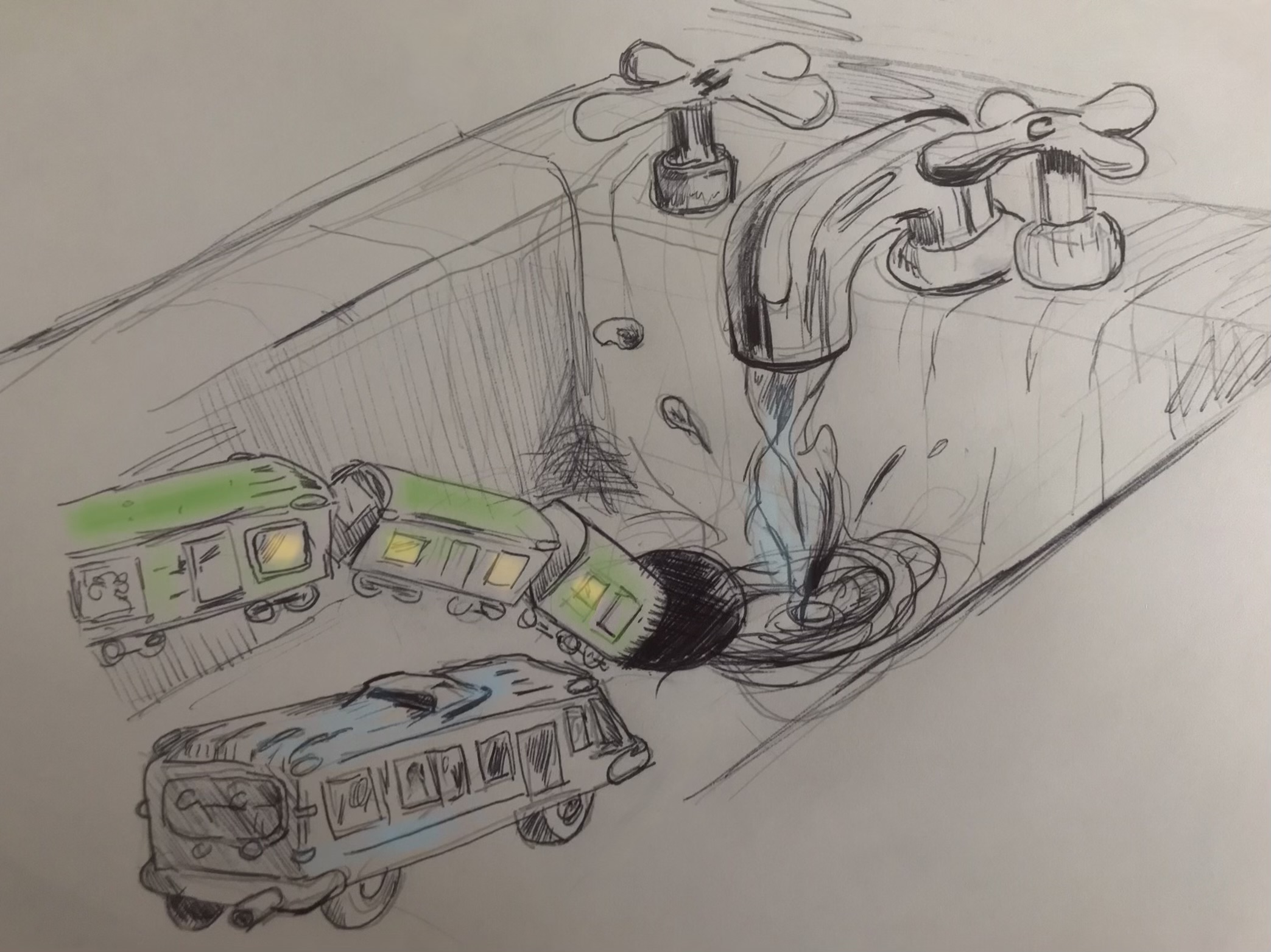Want to urge state legislators to properly fund Chicago-area transit during their spring 2025 session, so as to prevent drastic service cuts in 2026? The Active Transportation Alliance recommends going to the webpage "Support the Clean and Equitable Transportation Act!" to send letters to your state reps.
Last week the Regional Transportation Authority, which oversees the Chicago area's three transit systems, played Paul Revere. But instead of warning "The British are coming!" the RTA's press release spread the word that if no solution is reached soon for the region's approaching total $770 million public transportation budget gap, the results will be dire.
The looming fiscal chasm would be the result of local transit ridership still being only about 65 percent of 2019 levels, with federal COVID-19 era stimulus funds projected to run out in 2026. According to the RTA, if a funding agreement is not reached before the current Illinois legislative session wraps up in May, the CTA, Metra, and Pace will be forced to respond to the cash gap with service cuts.
The news release said that if that happens, "CTA will close or drastically reduce service to over 50 rail stations"; Pace would have to cut weekend runs; and Metra would have to get rid of late-night and early-morning service. What's more, almost 3,000 transit workers would lose their jobs. If all that happens, the RTA cautioned, "The Chicago region’s transit system will be decimated."
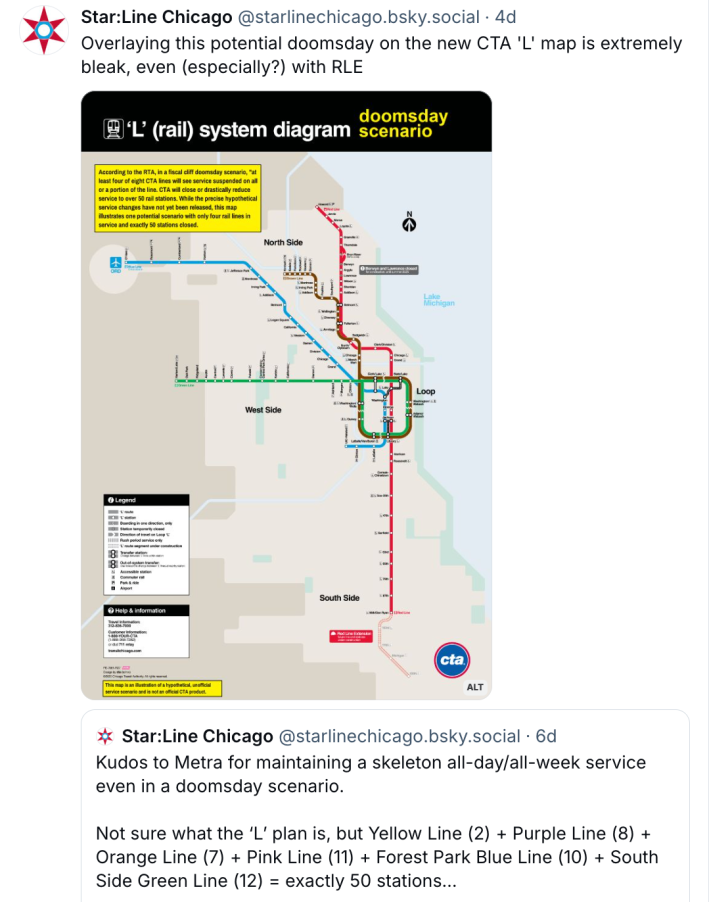
So the mood was sober at this morning's RTA board meeting at the agency's Loop headquarters, 175 W. Jackson Blvd. But there was still hope that Illinois legislators, some of whom have also been calling for transit governance reform, could find the $770 million. And many transit-friendly politicians and advocates have been calling for nearly doubling that number to $1.5 billion, which would allow for not only saving current transit, but greatly upgrading it. That would create "a virtuous cycle" of more ridership and revenue.
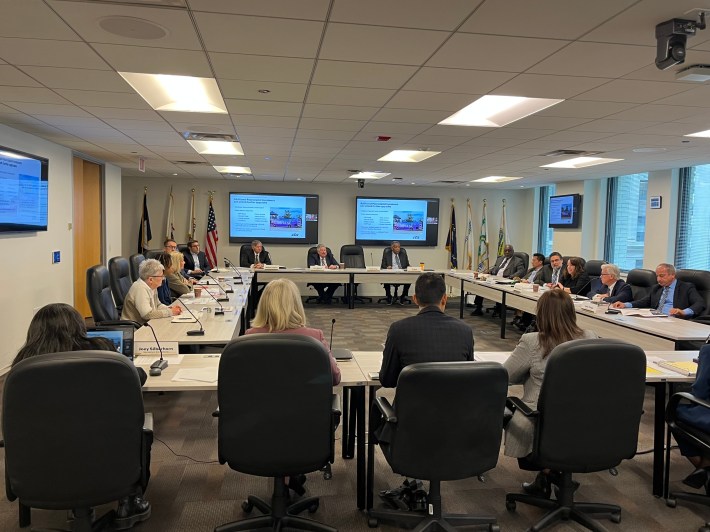
The hearing began with a public comment section, in which public transit users made passionate pleas to save Chicagoland transit from a doomsday scenario. Evanston resident Steven Leonard, who uses a wheelchair, said he mostly travels by Pace paratransit. "Not funding Pace, or the CTA or Metra would be a issue to not only my quality of life, but to others in my community who rely on Pace to be able to get places on a regular basis," he said. "So please try to make an effort to find the funding so services are not cut as proposed."
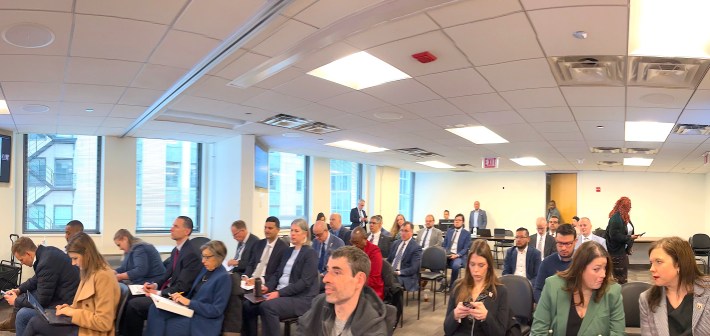
"Thank you, obviously I think every member of our board realizes that ADA paratransit is maybe even the most important things we do," responded RTA Board Chair Kirk Dillard. "It's not only a transportation issue, it's a civil rights issue. One of the things I would say – and we are fighting this and talking to legislators about it all the time – is while we have about a quarter of a billion dollars in expenses for ADA paratransit, it's a mandate, the State of Illinois only reimburses us about 4 percent of that quarter of a billion, so it is a massive, massive unfunded mandate from the State of Illinois, and you can rest assured, Steve, that we're going to do everything possible to make sure that ADA paratransit is available for you."
Next was Doug Fowler, who lives in a Joliet and is a member of the RTA Citizens Board. He said that for many City of Stone residents, being able to commute by Pace or Metra is the only thing allowing them to live their lives as they wish. "Many people don't have other transit options," he noted. "If someone... works in Chicago but lives in Joliet, and suddenly no longer has a feasible way to get there, they may find themself unable to live in their community, which for many people has been their home for all their life."

Fowler said his community is about 50 miles from downtown Chicago, so commuting by car would be "astronomical" in terms of gasoline costs. "Being able to have convenient Metra access was one of the largest selling points for why I chose to move to move to Joliet and start my family here," he said. "Being able to take my daughter into the city on a Metra train, which I've done nearly every Sunday for the past several years, is something that I'm so grateful for as a father."
"The transit services in our community are the circulatory system of the entire Chicagoland area," Fowler stated. "If they no longer exist as they do, many people who choose not to rely on cars would have no choice but to add that expense upon themselves." He noted that not only could that cost them thousands of dollars more a year in car expenses, it would also make the roads less safe, more congested, and more expensive to maintain. "We should not be cutting services, but expanding and investing in our transit system."
Dillard responded, "Your points are so well taken, and we will use you in a commercial for us." Board members and attendees chuckled.
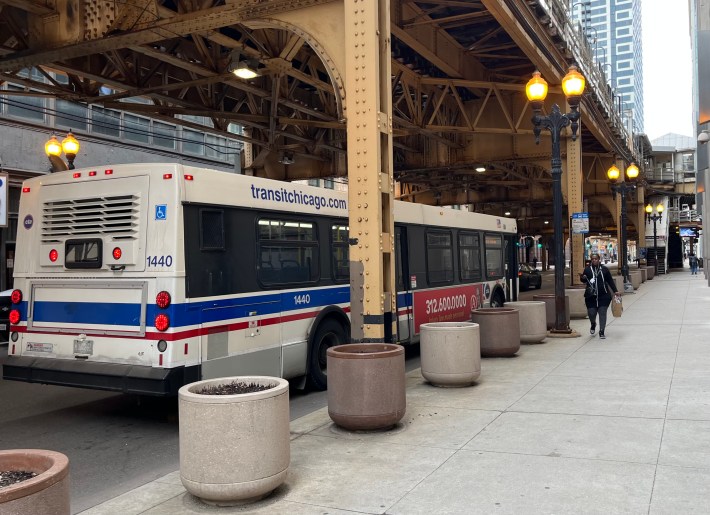
RTA Executive Director Leanne Redden then gave a report to the board. Among other updates, she discussed some troubling transit news from the Donald Trump administration. "On Tuesday, March 11, the U.S. Department of Transportation Secretary Sean Duffy [a former Fox News cohost and, like Trump, an ex-reality TV star] issued a directive to federal transportation agencies to undergo a project-by-project review of federal grant recipients, including projects with partially obligated funds... to identify projects that include 'equity', 'climate change', 'environmental justice', 'gender specific', 'bicycle infrastructure', and 'electric vehicle components'." (I wonder what Trump's sidekick, Tesla e-car manufacturer Elon Musk, thinks about that last one.)
While that's an ominous development, Redden added that "grant awards with fully obligated agreements are not subject to this review." Thankfully, that indicates that the $1.9 billion in federal funds recently allocated to Chicago's $5.7 billion Red Line Extension under Joe Biden is safe for now.
Later in the meeting, leaders of the three transit systems gave presentations about what would happen to their agencies without financial help from the State. They also talked about the benefits their systems would reap if the proposed $1.5 billion in aid materializes.
The CTA doomsday scenario discussed by acting CTA President Nora Leerhsen included the dozens of station closures as well as the loss of over 70 miles of rail service. 74 bus routes, 60 percent of all CTA bus lines, would be eliminated, giving us fewer routes than Madison, Wisconsin, or Kansas City.
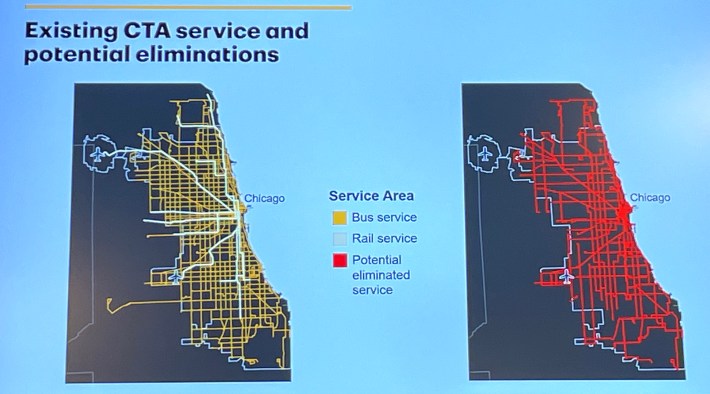
But if the $1.5 billion comes through, Leerhsen said there could be six-minute or better headways from 5 a.m. to 10 p.m. on every line, every day. There could be 47 bus routes with eight-minute headways in the new Frequent Bus Network, which launched last week with scheduled 10-minute waits between buses on eight lines. The agency says it could also build six new infill train stations, eliminate all 'L' slow zones, install 100 miles of bus-only lanes, and other goodies.
Metra Chief of Staff/Deputy Executive Director, External Affairs Janice Thomas presented the good news / bad news scenarios for that system. No funding help would mean potential elimination of the Metra Electric Line's Blue Island Branch, and overall service reduced by 40 percent. She also warned that it could take five years or more to restore any service that is cut, partly due to pushback from the freight railroads that use the same corridors.

On the bright side, the $1.5 billion bump could lead to only 30 minutes between runs on the Electric, Rock Island, UPNW, and UPN lines, Thomas said. She added that the extra funding would help the commuter railroad accomplish its Regional Rail 1.0 goal of at least a 50 percent increase in service.
Pace Executive Director Melinda Metzger shared the bad news that if Springfield doesn't come through with more funding, 62 suburban routes would offer no service after 8 p.m. 21 bus lines would only run every half hour, and 23 lines would merely run once an hour. Along with potential cuts to all weekend fixed-route bus service, the service area for paratransit would be reduced by 66 percent on Saturdays and Sundays, stranding people with disabilities.
But if legislators in Illinois, whose transit-friendly Governor JB Pritzker is currently worth $3.7 billion, opt to allocate less than half that sum to create a transit renaissance, below are some of the perks Metzger said could happen.
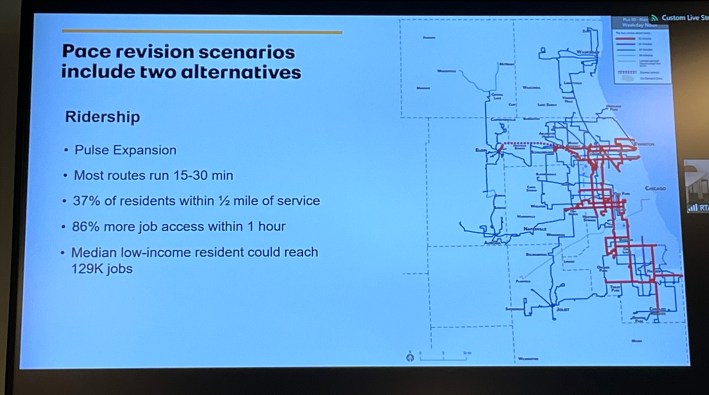

The board members generally expressed gratitude to the transit agencies for taking the bull by the horns with this issue. "I know it's hard to go and say, 'Wow, what would we do in a doomsday scenario,'" said director Michael Lewis.
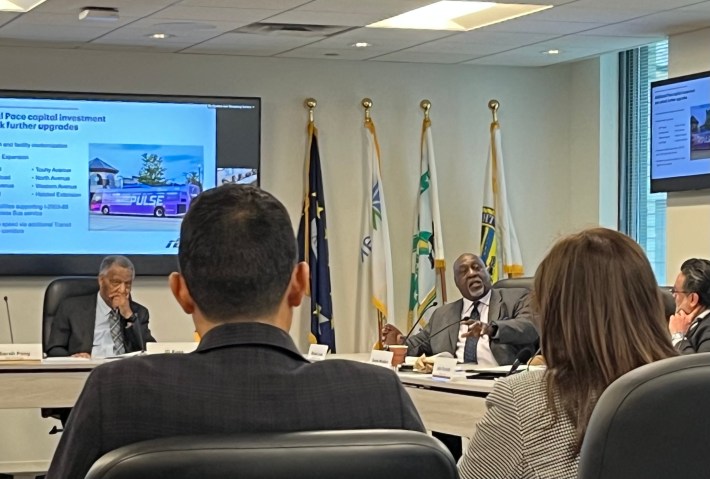
Director J.D. Ross did seem a bit impatient with the current debate over proposals to change the format of how Chicagoland' transit system decisions are made. For example, the proposed Metropolitan Mobility Authority act currently being discussed by state legislators, would combine the RTA, the CTA, Metra, and Pace into a single agency.
"We're totally misguided to believe our crisis can be solved by simply changing the governance," Ross argued. "Everything that we've heard today in terms of finance points to the fact that we don't have a governing restructuring problem, we have a financial restructuring problem... The system has some flaws and needs to be improved. But to think that in the middle of a financial crisis we would throw everything out the window to create a new system, I personally think is a serious mistake."
After the hearing, Pace's Metzger told Streetsblog it was a productive discussion. "The word has to get out: We need funding so that there won't be these drastic cuts," she said. "This was a good step forward. Now we have to go down to Springfield and keep the pressure on."
Want to urge state legislators to properly fund Chicago-area transit during their spring 2025 session, so as to prevent drastic service cuts in 2026? The Active Transportation Alliance recommends going to the webpage "Support the Clean and Equitable Transportation Act!" to send letters to your state reps.

Did you appreciate this post? Streetsblog Chicago is currently fundraising to help cover our 2025-26 budget. If you appreciate our reporting and advocacy on local sustainable transportation issues, please consider making a tax-deductible donation here. Thank you!
